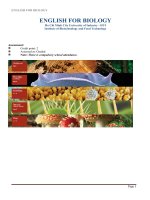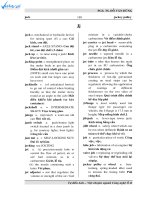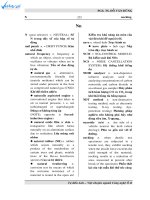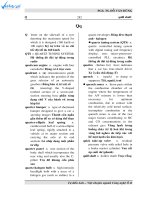ANH VĂN CHUYÊN NGÀNH CÔNG NGHỆ KỸ THUẬT HÓA HỌC
Bạn đang xem bản rút gọn của tài liệu. Xem và tải ngay bản đầy đủ của tài liệu tại đây (232.78 KB, 14 trang )
TRƯỜNG ĐẠI HỌC BÀ RỊA VŨNG TÀU
KHOA HÓA HỌC VÀ CƠNG NGHỆ THỰC PHẨM
Mơn học: ANH VĂN CHUN NGÀNH
CƠNG NGHỆ KỸ THUẬT HÓA HỌC
Objective of course: Training
speed reading and
comprehension skills the
English scientific texts, in
particularly of English chemical
scientific document.
Course including 10 lessons,
each consisting of two readings
on the different fields of
chemistry, a grammar revision
concerning to the readings and
the exercise.
COURSE PROGRAM: 10 lessons
-2 texts concerning to the chemical domain
- Grammar review
- Exercise
Level test
Translate into Vietnamese
Chemistry is the science of matter, especially its chemical
reactions, but also its composition, structure and properties.
Chemistry is concerned with atoms and their interactions with
other atoms, and particularly with the properties of chemical
bonds. Chemistry is sometimes called "the central science"
because it connects physics with other natural sciences such as
geology and biology. Chemistry is a branch of physical science
but distinct from physics.
Lesson 1: Text 1 - CHEMISTRY AND ITS BRANCHES
What is chemistry?
Chemistry is the science of substances - of their structure, their properties,
and the reactions that change them into other substances.
How many branches of the study of chemistry are there ?
Chemistry
General
Chemistry
Inorganic
Chemistry
Organic
Chemistry
Biogeochemistry
Oil chemistry
Analytic
Chemistry
Biology
Chemistry
Physical
Chemistry
Environmental Chemistry
Food chemistry
Lesson 1: Text 1 - CHEMISTRY AND ITS BRANCHES
What is General Chemistry ?
General chemistry, which is an introduction to the entire science chemistry
What is Inorganic Chemistry ?
Is the chemistry of elements other than carbon, and their compounds
What is organic Chemistry ?
Is the chemistry of the compounds of carbon
What is analytic Chemistry ?
Qualitative analysis
Giving the methods of testing for the presence of chemical substances
Quantitative analysis
Giving the methods of accurate determination of the amounts of different
substances present in the sample of material
Lesson 1: Text 1 - CHEMISTRY AND ITS BRANCHES
What is physical Chemistry?
studies the quantitative relationships between the properties of substances
and their reactions.
What is BioChemistry?
is a the chemistry of the substances comprising living organisms.
Chemistry science cannot do without physics and mathematics, and is also
closely linked to some other sciences, e.g. inorganic chemistry is linked closely
to geology, mineralogy, and metallurgy, while organic chemistry is linked to
biology in general.
What is chemical reaction?
A chemical reaction is a process that leads to the
transformation of one set of chemical substances to another
Part 2: Grammar
English grammar for Science and Technology
Composition: Thành phần
Composite: tổng hợp, hỗn hợp, phức tạp
Complex: phức tạp, phức chất
Compound: sự hóa hợp, hỗn hợp, thành phần (n), trộn lẫn, hóa hợp (v)
-Compounded (adj)
Concentration: nồn độ, (tập trung)
Concentrate: cơ đặc, tập trung (v) – concentrated - concentrating
Content : hàm lượng, lượng chứa (nội dung) – contain: chứa
Reaction: phản ứng – react (v) – reactant: chất phản ứng
Molecule : phân tử
Solution : dung dịch – soluble (adj) – solubility: độ tan
Solid: rắn >< liquid: lỏng
Solvent: dung môi
Compound oil: dầu hỗn hợp
Dissolve: hịa tan - dissolved
Compound fertilizer: phân bón hỗn hợp
Compounded essential oil: tinh dầu hỗn hợp
Complex cation: cation phức
Compound indicator: chỉ thị màu hỗn hợp
Complex conjugate: liên hợp phức Compound gauge: áp kế chân không
Complex formation: sự tạo phức Compound glass: thủy tinh nhiều lớp
Part 2: Grammar
English grammar for Science and Technology
concentration: nồng độ lưu huỳnh
Part 3: Exercise
1. Answer the following questions
a. Which are the main branches of chemistry?
b. What is the difference between qualitative and quantitative
analysis?
c. Which branches of chemistry are you interested in? Why?
2. Translate into Vietnamese
Chemistry, analysis, method, determination, reaction,
substances, material, element, inorganic, biochemistry,
organism, molecular, mineralogy, metallurgy, particular,
accurate, closely, geology, mineralogy, comprise, concern,
continue, sample
Part 3: Exercise
3. Translate into English
a. Hóa học là khoa học về vật chất riêng biệt.
b. Hóa học có 4 ngành cơ bản: Hóa vơ cơ, hóa hữu cơ, hóa lý
và hóa phân tích.
c. Hóa phân tích được chia làm định tính và định lượng
d. Q trình biến đổi từ chất này thành chất khác gọi là phản
ứng hóa học
Lesson 1: Text 2-The world of rocks and minerals
What is a mineral?
A mineral is a naturally occurring solid chemical substance formed through
biogeochemical processes, having characteristic chemical composition, highly
ordered atomic structure, and specific physical properties. By comparison, a
rock is an aggregate of minerals and/or mineraloids and does not have a
specific chemical composition. Minerals range in composition from pure
elements and simple salts to very complex silicates with thousands of known
forms. The study of minerals is called mineralogy.
Mineralogy is the study of chemistry, crystal structure, and physical (including
optical) properties of minerals. Specific studies within mineralogy include the
processes of mineral origin and formation, classification of minerals, their
geographical distribution, as well as their utilization.
Lesson 1:
Text 2. The world of rocks and minerals
What’s differences between minerals and rocks ?
A mineral is a naturally occurring solid with a definite chemical composition
and a specific crystalline structure. A rock is an aggregate of one or more
minerals. (A rock may also include organic remains and mineraloids.) Some
rocks are predominantly composed of just one mineral. For example,
limestone is a sedimentary rock composed almost entirely of the mineral
calcite. Other rocks contain many minerals, and the specific minerals in a
rock can vary widely. Some minerals, like quartz, mica or feldspar are
common, while others have been found in only four or five locations
worldwide. The vast majority of the rocks of the Earth's crust consist of
quartz, feldspar, mica, chlorite, kaolin, calcite, epidote, olivine, augite,
hornblende, magnetite, hematite, limonite and a few other minerals. Over
half of the mineral species known are so rare that they have only been found
in a handful of samples, and many are known from only one or two small
grains.
Lesson 1:
Text 2. The world of rocks and minerals
Lesson 1:
Text 2. The world of rocks and minerals
Agate Slice
Agates are some of the most beautifully
colored gemstones in the world, with a
myriad of different colors, hues and
patterns, caused by the deposition of
Silicon Dioxide dissolved in water
which crystalises out in a rock void.
Galena
Lead Sulphide, the principle ore from
which lead is derived, and silver too.
Normally found in igneous and
sedimentary rocks and can be found all
over the world.
Kyanite
A beautiful blue mineral of the silicate family,
and is found commercially in items as diverse
as electrical insulators, abrasives and
dinnerware. Seldom used in jewelry. A lovely
collectors' item!
AZURITE
Used for centuries as a blue pigment for artists
and sometimes, though rarely, used for
jewelery, is produced by weathering of copper
ore deposits. A delicate mineral, best kept in
cool, shaded conditions to preserve its deep
blue colour.









